

Mrs. Dalloway as a Geo Graphical Novel. Essay on Mrs. Dalloway by Virginia Woolf. Mrs. Dalloway and Cultural Space. RAYMOND WILLIAMS'S “STRUCTURE OF FEELING” AND THE PROBLEM OF DEMOCRATIC VALUES IN BRITAIN, 1938–1961. The Great War: Conscientious Objectors - Group. RAYMOND WILLIAMS'S “STRUCTURE OF FEELING” AND THE PROBLEM OF DEMOCRATIC VALUES IN BRITAIN, 1938–1961. Structures of feeling and socio‐cultural formations: the significance of literature and experience to Raymond Williams's sociology of culture - Filmer - 2003 - The British Journal of Sociology. RAYMOND WILLIAMS'S “STRUCTURE OF FEELING” AND THE PROBLEM OF DEMOCRATIC VALUES IN BRITAIN, 1938–1961. Repercussions of Henri Bergson’s Duration and Memory on Virginia Woolf’s Mrs. Dalloway. Mojulem - Woolf Online - Content - Contextual - Transcriptions. Virginia Woolf And The Poetics Of Depression - Books - Books. In 1940 the Nazis started bombing London and more than a million houses were destroyed, including Virginia Woolf's residency.
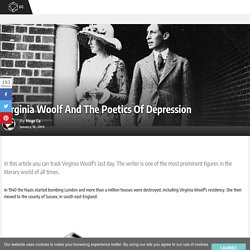
She then moved to the county of Sussex, in south east England. The influence of the German military was at its peak and nations stepped into a conflict of unimaginable scale, converting the second half of the twentieth century into a time of horror.Although the Second World War shook the world, for Virginia the world was already a burdensome place, even before the combat began. She struggled with poor health since her mother passed away in May 1895, when Virginia Woolf was only 13 years old. Nonetheless, the writer found comfort in the vivid and exciting childhood memories of her summer vacations in Saint Ives and Cornwall. “Lock up your libraries if you like; but there is no gate, no lock, no bolt that you can set upon the freedom of my mind.”When she was a little girl, she lived in the 22 Hyde Parkgate. Don't miss these: Virginia Woolf’s Forbidden Lesbian Love.
Gaston-Bachelard-the-Poetics-of-Space. Letter from Virginia Woolf to Frances Cornford about A Room of One's Own, 1929. In 1929 Virginia Woolf published A Room of One’s Own, a feminist treatise that urges readers to establish a new tradition of women’s writing and history-making.
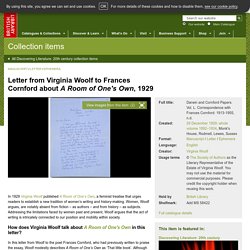
Women, Woolf argues, are notably absent from fiction – as authors – and from history – as subjects. Addressing the limitations faced by women past and present, Woolf argues that the act of writing is intricately connected to our position and mobility within society. How does Virginia Woolf talk about A Room of One's Own in this letter? In this letter from Woolf to the poet Frances Cornford, who had previously written to praise the essay, Woolf modestly describes A Room of One’s Own as ‘That little book’. Although evidently pleased to receive Cornford’s compliments, Woolf continues ‘[it was] rather a jump in the dark full of guesses + dashes + everything had to be boiled to a jelly in the hope that the young women would swallow it’.
When was the letter written? How does Virginia Woolf talk about A Room of One's Own in this letter? The_mark_on_the_wall. Www.google.co. Constellations - Unarticulated Pre-emergence - Page 2. It is precisely because of this vulnerability that Williams seeks to locate the living, actively-experienced structure of feeling, and why he is not content with the aesthetic surfaces of selectively traditional ‘cultural treasures’ which hegemonic forces have incorporated and abstracted.
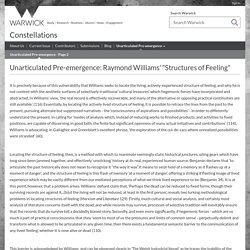
10. Modernism Lab. Bloomsbury Group Locations. British Museum, Great Russell Street Virginia Woolf, the writer at the centre of the Bloomsbury Group, immortalised Anthony Panizzi’s oak panelled 1857 Reading Room at the then British Library, ‘the vast dome … the huge, bald forehead which is so splendidly encircled by a band of famous names’, in A Room Of One’s Own (1929).

In Jacob’s Room (1922) the hero reads Marlowe in the library and watches other readers, including the atheist Fraser and the feminist Julia Hodge, and thinks of the Museum as an enormous mind. The British Library is no longer at the British Museum. It is now in its own, purpose-designed building at St Pancras (next to the station) - at the time of its construction notoriously condemned by Prince Charles as looking like "an academy for secret police. " What was the Bloomsbury group?
Old Bloomsbury and new Virginia and Vanessa moved from Kensington to Bloomsbury in 1904 after the death of their father, the celebrated writer and critic, Sir Leslie Stephen. 46 Gordon Square, their original Bloomsbury house, became a centre of artistic and intellectual activity when their brother Thoby brought his Cambridge University ‘Apostles’ friends to the ‘Thursday Evenings’ the sisters hosted.
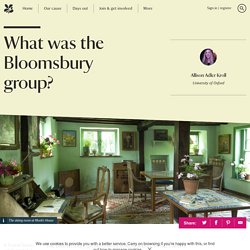
At these gatherings everything from the status of art to issues of Britain’s declining empire was subjected to intense scrutiny. How to assess skills during the interview process. RAYMOND WILLIAMS'S “STRUCTURE OF FEELING” AND THE PROBLEM OF DEMOCRATIC VALUE... Constellations - Unarticulated Pre-emergence - Page 2. Virginiawoolfmodernfiction. Marxism. The mental and physical health of miners following the 1992 national pit clos... New Historicism. New Historicism & Cultural Materialism: A Reader: Kiernan Ryan: Bloomsbury Ac... New Historicism and Cultural Materialism have become two of the most powerful and appealing movements in modern criticism.
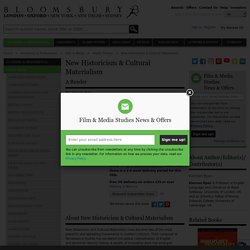
Their conquest of Renaissance studies has escalated into global colonialisation of English and American literary history. A wealth of innovative work has emerged on everything from the "Canterbury Tales" to the "Cantos", bringing intense theoretical controversy in its wake. New Historicism - Literary and Critical Theory - Oxford Bibliographies. Owing to its success, there has been no shortage of textbooks and anthology entries on new historicism, but it has often had to share space with British cultural materialism, a school that, though related, has an entirely distinct theoretical and methodological genesis.

The consequence of this dual treatment has resulted in a somewhat caricatured view of both approaches along the axis of subversion and containment, with new historicism representing the latter. While there is some truth to this shorthand account, any sustained engagement with new-historicist studies will reveal its limitations. Readers should be aware, therefore, that while accounts that contrast new historicism with cultural materialism—for example, Dollimore 1990, Wilson 1992, and Brannigan 1998—can be illuminating, they can also by the terms of that contrast tend to oversimplify. Be aware also that because new historicism has been a controversial development in the field, accounts are seldom entirely neutral. New Historicism and Cultural Materialism Today. New Historicism and Cultural Materialism. A term coined by Raymond Williams and popularised by Jonathan Dollimore and Alan Sinfield (in their collection of essays Political Shakespeare), Cultural Materialism refers to a Marxist orientation of New Historicism, characterised by the analysis of any historical material within a politicized framework, in a radical and subversive manner.
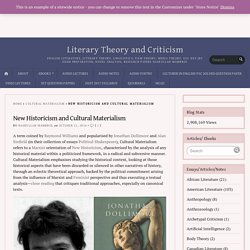
Cultural Materialism emphasises studying the historical context, looking at those historical aspects that have been discarded or silenced in other narratives of history, through an eclectic theoretical approach, backed by the political commitment arising from the influence of Marxist and Feminist perspective and thus executing a textual analysis—close reading that critiques traditional approaches, especially on canonical texts. Like this: Like Loading... Literary Theory and Criticism. Marxism is a materialist philosophy which tried to interpret the world based on the concrete, natural world around us and the society we live in.
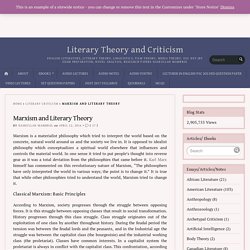
It is opposed to idealist philosophy which conceptualizes a spiritual world elsewhere that influences and controls the material world. In one sense it tried to put people’s thought into reverse gear as it was a total deviation from the philosophies that came before it. Karl Marx himself has commented on this revolutionary nature of Marxism, “The philosophers have only interpreted the world in various ways; the point is to change it.” It is true that while other philosophies tried to understand the world, Marxism tried to change it.
Classical Marxism: Basic Principles According to Marxism, society progresses through the struggle between opposing forces. The Bloomsbury Group's Most Famous Work of Art. Hidden among the chalk hills of East Sussex is Charleston, the sixteenth-century farmhouse and gardens that the Bloomsbury Group transformed into their most famous work of art.

When Vanessa Bell signed the first of a series of long leases on the property in October 1916, she treated the house’s interior as a blank canvas. Murals and patterns were painted directly onto whitewashed walls, stripped doors, fireplaces, and bedsteads; even the wooden cladding around the bathtubs wasn’t off-limits for decoration. Today, to visit Charleston—which has been open to the public since 1986, but has just launched its first exhibition and event spaces, along with a new restaurant—is to be transported back in time. Even the plants in the garden have been painstakingly chosen to replicate those from the house’s heyday within the three decades 1930–1959. Dorothy Parker famously quipped that the cohort “lived in squares, painted in circles and loved in triangles.” Boom time for the Bloomsbury group. The tulips stand upright, petals flaring.
Pale pink apple blossom hangs over clumps of forget-me-nots. Box grows in funny humps and bumps, far from the coiffed topiary of more formal English gardens. A blackbird is singing. Lifestyle and Legacy of the Bloomsbury Group – Look Closer. Introduction. Journal of Lady Ottoline Morrell, 1917, with accounts of Virginia Woolf and Siegfried Sassoon. The British Library holds the papers of Lady Ottoline Morrell, consisting of diaries, notebooks, letters and photographs. This is Morrell’s journal for 27 March 1917 to 2 September 1918, recording life at Garsington.